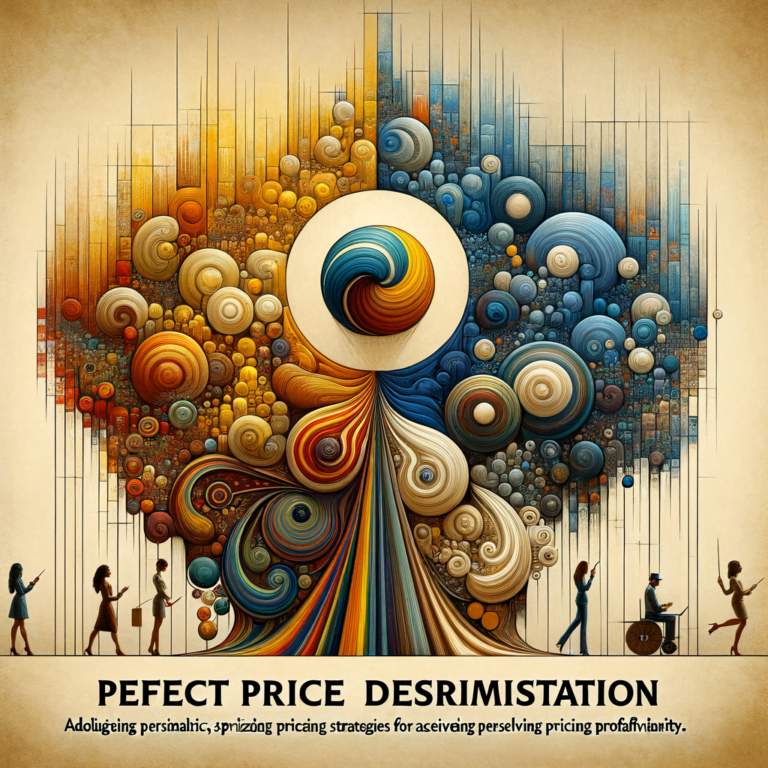Table of Contents
The Basics of Perfect Price Discrimination
Imagine walking into a store and seeing two customers purchasing the same product. One customer pays $50, while the other pays $100. How is this possible? This scenario is a classic example of price discrimination, a strategy used by businesses to maximize profits by charging different prices to different customers based on their willingness to pay.
- Definition: Price discrimination is the practice of charging different prices to different customers for the same product or service.
- Types of Price Discrimination: There are three main types of price discrimination: first-degree, second-degree, and third-degree.
First-degree price discrimination, also known as perfect price discrimination, is the most efficient form of price discrimination. In this scenario, a seller charges each customer the maximum price they are willing to pay for a product or service. This allows the seller to capture the entire consumer surplus, resulting in maximum profitability.
Perfect price discrimination is often compared to a hypothetical scenario where a seller knows exactly how much each customer is willing to pay and charges them that exact amount. While this level of information is rarely achievable in reality, businesses can still implement strategies to get as close to perfect price discrimination as possible.
Strategies for Implementing Perfect Price Discrimination
Businesses can use various strategies to personalize pricing and increase profitability through perfect price discrimination. Let's explore some of these strategies:
- Data Collection: Collecting data on customer preferences, purchasing behavior, and willingness to pay is essential for implementing perfect price discrimination. Businesses can use surveys, loyalty programs, and online tracking to gather this valuable information.
- Pricing Tiers: Creating different pricing tiers based on customer segments allows businesses to charge higher prices to customers who are willing to pay more. For example, airlines offer different ticket classes with varying levels of service and pricing to cater to different customer segments.
- Dynamic Pricing: Adjusting prices in real-time based on demand, competition, and other factors can help businesses capture more value from customers. Online retailers often use dynamic pricing algorithms to set prices based on customer behavior and market conditions.
By implementing these strategies, businesses can move closer to achieving perfect price discrimination and increase their profitability. However, it's essential to balance pricing strategies with customer satisfaction and ethical considerations to maintain long-term relationships with customers.
Now, let's look at some real-world examples of perfect price discrimination in action:
- Canadian Example: In Canada, telecommunications companies often offer personalized pricing plans based on customer usage patterns and preferences. By tailoring pricing to individual customers, these companies can maximize revenue while providing value to customers.
- American Example: In the United States, streaming services like Netflix use personalized pricing based on user behavior and viewing habits. By offering different subscription tiers with varying features and prices, Netflix can capture more value from customers who are willing to pay for premium content.
As consumers, understanding how businesses use pricing strategies like perfect price discrimination can help us make informed purchasing decisions and advocate for fair pricing practices. By being aware of these strategies, we can empower ourselves to negotiate better deals and seek out value in the marketplace.
Practical Exercises for Applying Perfect Price Discrimination Concepts
1. Conduct a survey among your friends or family members to understand their willingness to pay for a specific product or service. Use this information to create personalized pricing tiers and analyze how it could impact profitability.
2. Monitor prices of a particular product or service online over a week and observe any fluctuations. Research dynamic pricing strategies used by businesses in that industry and discuss how they influence your purchasing decisions.
By engaging in these practical exercises, you can gain a deeper understanding of perfect price discrimination and its implications for businesses and consumers alike. Remember, knowledge is power when it comes to navigating the complex world of pricing strategies!
I'll conclude by adding that I'm doing my best to clarify and simplify these topics. But remember that these little essays are only the beginning, and I encourage you to continue reading, learning, and exploring. To assist you, here are a few books about economics that will prepare you for your journey into the world of finance:












